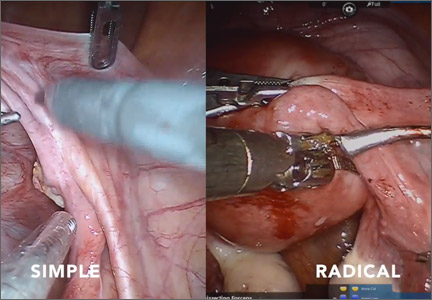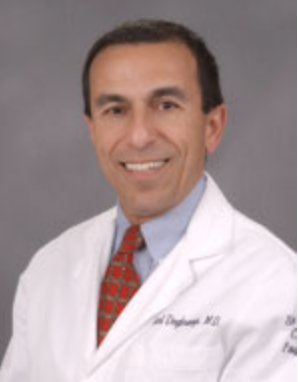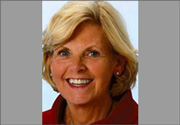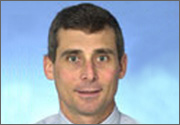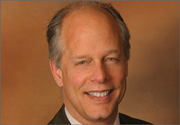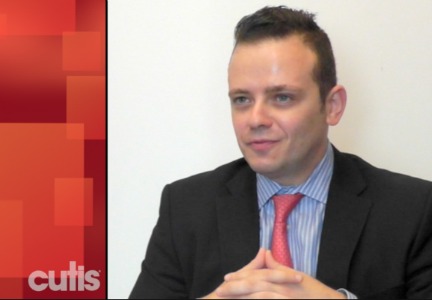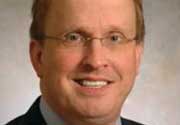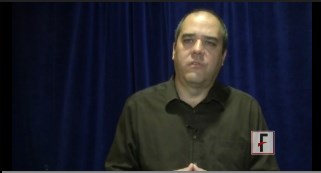User login
Simple versus radical hysterectomy
Hysterectomy is one of the fundamental surgical procedures in gynecology. Understanding the nuances of both the anatomy and the surgical dissection techniques of this procedure is especially important when approaching complex cases in either benign or oncologic settings.
This month’s surgical video contribution is by my gynecologic oncology colleagues, who highlight the key differences between the simple and radical hysterectomy. They emphasize key surgical principles for the benefit of both benign and oncologic surgeons.
The objectives of this video are to:
- compare the surgical techniques of a simple versus radical hysterectomy
- review the relevant anatomy as it relates to the varying types of hysterectomy
- provide an educational review of the different types of hysterectomy.
This video does an excellent job of achieving its objectives. I hope you share it with your colleagues and residents.

Share your thoughts on this video! Send your Letter to the Editor to rbarbieri@frontlinemedcom.com. Please include your name and the city and state in which you practice.
Hysterectomy is one of the fundamental surgical procedures in gynecology. Understanding the nuances of both the anatomy and the surgical dissection techniques of this procedure is especially important when approaching complex cases in either benign or oncologic settings.
This month’s surgical video contribution is by my gynecologic oncology colleagues, who highlight the key differences between the simple and radical hysterectomy. They emphasize key surgical principles for the benefit of both benign and oncologic surgeons.
The objectives of this video are to:
- compare the surgical techniques of a simple versus radical hysterectomy
- review the relevant anatomy as it relates to the varying types of hysterectomy
- provide an educational review of the different types of hysterectomy.
This video does an excellent job of achieving its objectives. I hope you share it with your colleagues and residents.

Share your thoughts on this video! Send your Letter to the Editor to rbarbieri@frontlinemedcom.com. Please include your name and the city and state in which you practice.
Hysterectomy is one of the fundamental surgical procedures in gynecology. Understanding the nuances of both the anatomy and the surgical dissection techniques of this procedure is especially important when approaching complex cases in either benign or oncologic settings.
This month’s surgical video contribution is by my gynecologic oncology colleagues, who highlight the key differences between the simple and radical hysterectomy. They emphasize key surgical principles for the benefit of both benign and oncologic surgeons.
The objectives of this video are to:
- compare the surgical techniques of a simple versus radical hysterectomy
- review the relevant anatomy as it relates to the varying types of hysterectomy
- provide an educational review of the different types of hysterectomy.
This video does an excellent job of achieving its objectives. I hope you share it with your colleagues and residents.

Share your thoughts on this video! Send your Letter to the Editor to rbarbieri@frontlinemedcom.com. Please include your name and the city and state in which you practice.
Sedating antidepressants for insomnia
The video associated with this article is no longer available on this site. Please view all of our videos on the MDedge YouTube channel
The video associated with this article is no longer available on this site. Please view all of our videos on the MDedge YouTube channel
The video associated with this article is no longer available on this site. Please view all of our videos on the MDedge YouTube channel
5 Nonglycemic Vascular Risk Factors
The video associated with this article is no longer available on this site. Please view all of our videos on the MDedge YouTube channel
The video associated with this article is no longer available on this site. Please view all of our videos on the MDedge YouTube channel
The video associated with this article is no longer available on this site. Please view all of our videos on the MDedge YouTube channel
New Onset Diabetes in Adults: Type 1 and Type 2 Differences
The video associated with this article is no longer available on this site. Please view all of our videos on the MDedge YouTube channel
The video associated with this article is no longer available on this site. Please view all of our videos on the MDedge YouTube channel
The video associated with this article is no longer available on this site. Please view all of our videos on the MDedge YouTube channel
Reconfiguring Management of Patients With Osteoporosis
The video associated with this article is no longer available on this site. Please view all of our videos on the MDedge YouTube channel
The video associated with this article is no longer available on this site. Please view all of our videos on the MDedge YouTube channel
The video associated with this article is no longer available on this site. Please view all of our videos on the MDedge YouTube channel
Manage Your Dermatology Practice: Attracting New Dermatology Patients
Attracting patients to your dermatology practice requires a multipronged approach. Dr. Gary Goldenberg discusses how technology and referrals will impact your patient base. Patient reviews also will affect your practice.
Attracting patients to your dermatology practice requires a multipronged approach. Dr. Gary Goldenberg discusses how technology and referrals will impact your patient base. Patient reviews also will affect your practice.
Attracting patients to your dermatology practice requires a multipronged approach. Dr. Gary Goldenberg discusses how technology and referrals will impact your patient base. Patient reviews also will affect your practice.
‘Acting out’ or pathological?
VIDEO: SABCS 2014 roundtable with Dr. William J. Gradishar and Dr. Hope S. Rugo
SAN ANTONIO – The Oncology Report associate editors Dr. William J. Gradishar and Dr. Hope S. Rugo discuss highlights presented at the 2014 San Antonio Breast Cancer Symposium.
First reports on checkpoint inhibitors for the treatment of breast cancer, the unique study issues to consider in investigating these immunotherapy options, disappointing results from the FERGI trial, which looked at a combination therapy with a PI3 kinase inhibitor, and overall survival data from the FIRST trial of endocrine therapy with fulvestrant for patients with advanced disease were some of the topics Dr. Gradishar and Dr. Rugo weighed in on during the discussion.
The TNT trial comparing carboplatin to docetaxel in treating patients with triple-negative breast cancer; the latest results from the SOFT trial, looking at ovarian suppression in combination with either an aromatase inhibitor or tamoxifen; and the mixed results from BOLERO-1 looking at the addition of an mTOR inhibitor to the treatment of patients with advanced HER2-positive disease were also discussed.
Dr. Gradishar is the Betsy Bramsen Professor of Breast Oncology at the Northwestern University, Chicago. Dr. Rugo is a professor of medicine, University of California, San Francisco, and director, breast oncology and clinical trials education, UCSF Helen Diller Family Comprehensive Cancer Center.
The video associated with this article is no longer available on this site. Please view all of our videos on the MDedge YouTube channel
SAN ANTONIO – The Oncology Report associate editors Dr. William J. Gradishar and Dr. Hope S. Rugo discuss highlights presented at the 2014 San Antonio Breast Cancer Symposium.
First reports on checkpoint inhibitors for the treatment of breast cancer, the unique study issues to consider in investigating these immunotherapy options, disappointing results from the FERGI trial, which looked at a combination therapy with a PI3 kinase inhibitor, and overall survival data from the FIRST trial of endocrine therapy with fulvestrant for patients with advanced disease were some of the topics Dr. Gradishar and Dr. Rugo weighed in on during the discussion.
The TNT trial comparing carboplatin to docetaxel in treating patients with triple-negative breast cancer; the latest results from the SOFT trial, looking at ovarian suppression in combination with either an aromatase inhibitor or tamoxifen; and the mixed results from BOLERO-1 looking at the addition of an mTOR inhibitor to the treatment of patients with advanced HER2-positive disease were also discussed.
Dr. Gradishar is the Betsy Bramsen Professor of Breast Oncology at the Northwestern University, Chicago. Dr. Rugo is a professor of medicine, University of California, San Francisco, and director, breast oncology and clinical trials education, UCSF Helen Diller Family Comprehensive Cancer Center.
The video associated with this article is no longer available on this site. Please view all of our videos on the MDedge YouTube channel
SAN ANTONIO – The Oncology Report associate editors Dr. William J. Gradishar and Dr. Hope S. Rugo discuss highlights presented at the 2014 San Antonio Breast Cancer Symposium.
First reports on checkpoint inhibitors for the treatment of breast cancer, the unique study issues to consider in investigating these immunotherapy options, disappointing results from the FERGI trial, which looked at a combination therapy with a PI3 kinase inhibitor, and overall survival data from the FIRST trial of endocrine therapy with fulvestrant for patients with advanced disease were some of the topics Dr. Gradishar and Dr. Rugo weighed in on during the discussion.
The TNT trial comparing carboplatin to docetaxel in treating patients with triple-negative breast cancer; the latest results from the SOFT trial, looking at ovarian suppression in combination with either an aromatase inhibitor or tamoxifen; and the mixed results from BOLERO-1 looking at the addition of an mTOR inhibitor to the treatment of patients with advanced HER2-positive disease were also discussed.
Dr. Gradishar is the Betsy Bramsen Professor of Breast Oncology at the Northwestern University, Chicago. Dr. Rugo is a professor of medicine, University of California, San Francisco, and director, breast oncology and clinical trials education, UCSF Helen Diller Family Comprehensive Cancer Center.
The video associated with this article is no longer available on this site. Please view all of our videos on the MDedge YouTube channel
EXPERT ANALYSIS FROM SABCS 2014
VIDEO: For family physicians, ‘Death is not a defeat’
NEW YORK– Family physicians are more comfortable with letting patients choose to die, and helping them do so comfortably, according to Dr. Richard Young, a speaker at this year’s annual meeting of the North American Primary Care Research Group.
“We’re more comfortable with death,” he said, comparing physicians accustomed to focusing on one part of the body rather than the whole. That can lead to unnecessary pain and agony for the patient and family, who would be better served being made comfortable, rather than having to endure the heroics of a specialist who “can’t let go,” noted Dr. Young, director of research at the John S. Peters Health System in Fort Worth, Tex.
This video interview is the third in a four-part series on the role family medicine plays in delivering humane, cost-effective health care.
The video associated with this article is no longer available on this site. Please view all of our videos on the MDedge YouTube channel
On Twitter @whitneymcknight
NEW YORK– Family physicians are more comfortable with letting patients choose to die, and helping them do so comfortably, according to Dr. Richard Young, a speaker at this year’s annual meeting of the North American Primary Care Research Group.
“We’re more comfortable with death,” he said, comparing physicians accustomed to focusing on one part of the body rather than the whole. That can lead to unnecessary pain and agony for the patient and family, who would be better served being made comfortable, rather than having to endure the heroics of a specialist who “can’t let go,” noted Dr. Young, director of research at the John S. Peters Health System in Fort Worth, Tex.
This video interview is the third in a four-part series on the role family medicine plays in delivering humane, cost-effective health care.
The video associated with this article is no longer available on this site. Please view all of our videos on the MDedge YouTube channel
On Twitter @whitneymcknight
NEW YORK– Family physicians are more comfortable with letting patients choose to die, and helping them do so comfortably, according to Dr. Richard Young, a speaker at this year’s annual meeting of the North American Primary Care Research Group.
“We’re more comfortable with death,” he said, comparing physicians accustomed to focusing on one part of the body rather than the whole. That can lead to unnecessary pain and agony for the patient and family, who would be better served being made comfortable, rather than having to endure the heroics of a specialist who “can’t let go,” noted Dr. Young, director of research at the John S. Peters Health System in Fort Worth, Tex.
This video interview is the third in a four-part series on the role family medicine plays in delivering humane, cost-effective health care.
The video associated with this article is no longer available on this site. Please view all of our videos on the MDedge YouTube channel
On Twitter @whitneymcknight
EXPERT ANALYSIS FROM NAPCRG 2014
VIDEO: Data support family physicians’ cost-effective care methods
NEW YORK – Family physicians are comfortable with uncertainty and view many tests as wastes of money.
These and other characteristics typical of family physicians are what Dr. Richard A. Young calls the foundation of the nation’s most practical and cost-effective care, despite what he calls “bigotry” toward the field from more specialized medicine and from those who created the current system of payment.
“The reason we add value to the world is because we don’t treat everybody the same,” said Dr. Young, the director of research and residency at the John Peter Smith Health System in Fort Worth, Tex.
In this video interview, the fourth and final in a series, Dr. Young makes the case for how, despite systematic overreliance on specialty care, evidence shows it is the primary care physician who is best suited to meet the majority of patients’ needs.
The video associated with this article is no longer available on this site. Please view all of our videos on the MDedge YouTube channel
On Twitter @whitneymcknight
NEW YORK – Family physicians are comfortable with uncertainty and view many tests as wastes of money.
These and other characteristics typical of family physicians are what Dr. Richard A. Young calls the foundation of the nation’s most practical and cost-effective care, despite what he calls “bigotry” toward the field from more specialized medicine and from those who created the current system of payment.
“The reason we add value to the world is because we don’t treat everybody the same,” said Dr. Young, the director of research and residency at the John Peter Smith Health System in Fort Worth, Tex.
In this video interview, the fourth and final in a series, Dr. Young makes the case for how, despite systematic overreliance on specialty care, evidence shows it is the primary care physician who is best suited to meet the majority of patients’ needs.
The video associated with this article is no longer available on this site. Please view all of our videos on the MDedge YouTube channel
On Twitter @whitneymcknight
NEW YORK – Family physicians are comfortable with uncertainty and view many tests as wastes of money.
These and other characteristics typical of family physicians are what Dr. Richard A. Young calls the foundation of the nation’s most practical and cost-effective care, despite what he calls “bigotry” toward the field from more specialized medicine and from those who created the current system of payment.
“The reason we add value to the world is because we don’t treat everybody the same,” said Dr. Young, the director of research and residency at the John Peter Smith Health System in Fort Worth, Tex.
In this video interview, the fourth and final in a series, Dr. Young makes the case for how, despite systematic overreliance on specialty care, evidence shows it is the primary care physician who is best suited to meet the majority of patients’ needs.
The video associated with this article is no longer available on this site. Please view all of our videos on the MDedge YouTube channel
On Twitter @whitneymcknight
EXPERT ANALYSIS FROM NAPCRG 2014
